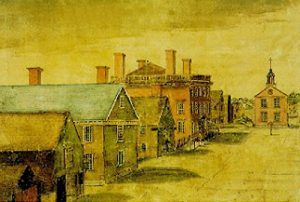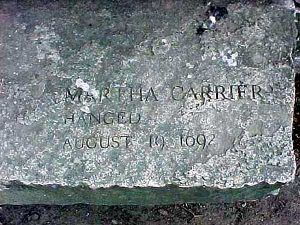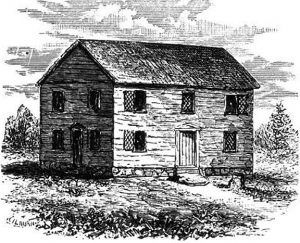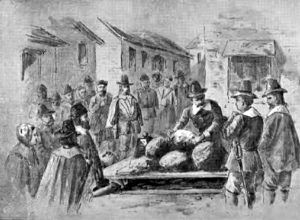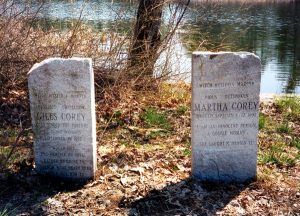Witches of Salem: Index A B C D E F-G H I-J K-N O-P Q-S T U-Z
Candy (No Known Last Name) – An African-American slave from Barbados, Candy belonged to Margaret Hawkes of Salem Village. She was examined on July 4, 1692, saying that her mistress, Margaret Hawkes, had made her a witch and taught her the craft. She also said that she had made her mark in the Devil’s book when Mrs. Hawkes had presented it to her. The curious magistrates asked Candy to produce the poppets that she claimed she used to torment people. Accompanied by a court-appointed deputy, she was escorted home and returned with rags of cloth, a piece of cheese, some grass, and a handkerchief tied with several knots. Deciding to experiment with Candy’s tools of the trade, the magistrates burned one of the rags, and allegedly, a burn appeared on the hand of one of the “afflicted girls.” Two more choked as if drowning when another rag was placed underwater. Two indictments were handed down against Candy, and she was jailed. Later, she was found not guilty and released.
Andrew Carrier (1677-1749) – The son of Thomas and of Andover, Andrew and his siblings would be examined after their mother was arrested for witchcraft on May 28, 1692. All four children would confess to witchcraft and be imprisoned. Just a week later, their mother, Martha Allen Carrier, was hanged on August 19, 1692. The children would later be released. Andrew would marry Mary Adams in January 1704/05 in Colchester, Connecticut. He would die in the same town on July 23, 1749, and was interred at the Old Burying Ground.
Martha Allen Carrier (1650?-1692) – Born between 1643 and 1650 to Andrew and Faith Ingalls Allen, one of the founding families of Andover, Massachusetts. She grew up to marry Thomas Carrier, a recently arrived bondservant, in May 1664. At that time, she was already seven months pregnant with her eldest child, and the couple would go on to have three more. Somewhere along the line, the couple moved to Billerica, about ten miles southwest of Andover. However, the couple returned to Andover when her father and brothers were suffering from smallpox in 1690. Unsuccessful in nursing them back to health, she soon became a landowner in her own right. Though the couple lost two of their children to the disease, they were blamed for having brought the disease to Andover.
Some believe that Martha was accused of witchcraft because she was a niece of the Reverend Francis Dane of Andover, who condemned the witch hunts and trials. At that time, over one-third of the Salem accused were related to him or his wife in some way. Other historians have blamed her accusation on causes ranging from a conspiracy against Andover’s proprietary families in reaction against threats to patriarchal inheritance. She was also known to have had an independence of mind and an unsubmissive character, which made her vulnerable.
The first accused “witch” in Andover, Martha, was accused by her neighbor, Benjamin Abbot after they had gotten into an argument that involved a land dispute. After the disagreement, Abbot fell sick and blamed his illness on her bewitching him and would later testify that she had killed one of his cows. On May 28, 1692, Martha Carrier, along with her sister and brother-in-law, Mary Toothaker and Roger Toothaker of Billerica, and their 9-year-old daughter, Margaret, was arrested and charged with witchcraft. On May 31st, Carrier was examined by Judges John Hathorne, Jonathan Corwin, and Bartholomew Gedney. Testifying against her were several of the “afflicted girls”, including Susanna Sheldon, Mary Walcott, Elizabeth Hubbard and Ann Putnam, Jr. She pled not guilty and accused the girls of lying. Martha’s youngest children were also coerced into testifying against their mother in July; Ann Foster also implicated her.
In the meantime, her children, including 18-year-old Richard Carrier, 15-year-old Andrew Carrier, ten-year-old Thomas Carrier, Jr., and seven-year-old Sarah Carrier, were also accused. Her seven-year-old daughter, Sarah, testified to having been a witch since the age of six, converted by her mother, who could take the form of a cat. Evidence against her, besides the “fits,” was the testimony of confessed witches, who claimed the devil had promised to make her the “Queen of Hell.” Neighbors came to testify that Martha had somehow haunted them; a young girl heard Martha’s disembodied voice in the woods; an old man argued with Martha and got sick. During her trial, as the girls were writhing around on the floor, shrieking and wailing, saying they saw thirteen ghosts of the people she killed floating about the room, Martha looked to the judge and said, “It is a shameful thing that you should mind these folks that are out of their wits.”
Though her children would survive, Martha would not be so lucky. She was pronounced guilty on August 2nd and hanged on August 19, 1692, along with George Burroughs, George Jacobs, Sr., John Proctor, and John Willard. From the scaffold, she shouted that she refused to confess to “a falsehood so filthy” in order to avoid hanging. Cotton Mather was an observer at this hanging and, in his diary, noted Martha Carrier as a “rampant hag” and possibly the “Queen of Hell.”
During her trial, Cotton Mather, a prominent Boston Minister, directed the event to be fully transcribed, as he believed the case to represent the strongest example for the use of spectral evidence. The evidence he found persuasive was the testimony of Martha’s 18-year-old son, Richard, and her 8-year-old daughter, Sarah, who said she made them become witches to “haunt” others at her direction. However, John Proctor (who was hung the same day as Martha) wrote the governor that he witnessed these children’s torture in the jail where he was also imprisoned, stating that they were reportedly tied neck to ankles with a rope down their backs and left that way until said what their interrogators wanted to hear.
Richard Carrier (1674-1749) – The son of Thomas and Martha Allen Carrier of Andover, Richard and his siblings would be examined after their mother was arrested for witchcraft on May 28, 1692. All four children would confess to witchcraft and be imprisoned. Just a week later, their mother, Martha Allen Carrier, was hanged on August 19, 1692. The children would later be released. He died in Colchester, Connecticut in November 1749 and was interred at the Old Burying Ground.
Sarah Carrier (1684-1772) – The seven-year-old daughter of Thomas and Martha Allen Carrier, she and her three siblings would be among those accused of witchcraft in Andover, Massachusetts. After her mother, Martha, was arrested for witchcraft on May 28, 1692, she and her siblings were brought in to be examined. Young Sarah unwittingly helped to send her mother to the gallows by relating that her mother had “baptized” her, as well as her siblings, into the Devil’s service. Sarah also testified against her aunt and uncle, Roger and Mary Allen Toothaker, and their 10-year-old daughter, Margaret. Just a week after Sarah and her siblings testified, their mother, Martha Allen Carrier, was hanged on August 19, 1692. All four of the Carrier children would themselves confess to witchcraft and be imprisoned. However, they would all be later released. She would grow up to marry John Chapman. She died on December 6, 1772.
Thomas Carrier, Jr. (1682-1739) – The son of Thomas and Martha Allen Carrier of Andover, Thomas, Jr. and his siblings would be examined after their mother was arrested for witchcraft on May 28, 1692. All four children would confess to witchcraft and be imprisoned. Just a week later, their mother, Martha Allen Carrier, was hanged on August 19, 1692. The children would later be released. He would grow up to marry Susanna Johnson of Andover on June 19, 1705. He died on July 18, 1739.
Hannah Carroll – Married to Nathaniel Carroll, a warrant was issued on September 10, 1692, for Hannah Carroll and Sarah Cole for having afflicted William Brage, the son of Henry Brage. Of Salem Towne, the two women were arrested, but nothing more is known of them.
Bethiah Pearson Carter (1645-??) – Bethiah Pearson was born in Lynn, Massachusetts, in 1645, and as a child, she and her sister had thought themselves bewitched by the healer Ann Holland Bassett Burt, the grandmother of accused witch Elizabeth Bassett Proctor. She grew up to marry Captain Joseph Carter Jr., with whom she would have seven children. Her husband died in about 1690. Not long afterward, she became the target of gossip, perhaps because her own marriage was not a happy one. On May 8, 1692, the widow, Bethia Carter of Woburn, and her daughter of the same name were arrested for witchcraft upon the complaint of Sargeant Thomas Putnam, Jr. and his cousin, Constable John Putnam. Along the Carter women, the complaint also alleged that Ann Farrar Sears, also of Woburn, and Sarah Dustin of Reading were suspected of having afflicted Ann Putnam, Jr., Mercy Lewis, and Mary Walcott. The women were brought in, but Bethiah Carter, Jr. was not jailed with the rest, having been released shortly after she was examined. Bethiah Pearson Carter, Sr. was imprisoned.
Bethiah Carter, Jr. (1671-??) – On May 8, 1692, 21-year-old Bethia Carter of Woburn and mother of the same name, were arrested for witchcraft upon the complaint of Sargeant Thomas Putnam, Jr. and his cousin, Constable John Putnam, which alleged that they had afflicted Ann Putnam, Jr., Mercy Lewis, and Mary Walcott. After being examined, Bethiah Carter, Jr. was set free, but her mother was imprisoned until December 1692.
Elizabeth Walker Cary (1650-1722) – Born to Captain Augustine and Hannah Walker in about 1650, Elizabeth grew up to marry Captain Nathaniel Cary on July 9, 1674, in Lancashire, Massachusetts. Settling in Charlestown, the couple would eventually have at least five children. Despite the fact that her husband was a man of some influence, or, perhaps because of it, Elizabeth was accused of witchcraft. A complaint was sworn out against her on May 28, 1692, by Thomas Putnam and Benjamin Hutchinson of Salem Village, accusing Elizabeth of having afflicted Mary Walcott, Abigail Williams, and Mercy Lewis. She was examined the next day, where John Indian also was a witness against her, and the “touch test” was utilized with several of the “afflicted girls” who were falling into fits during the proceedings. When the examination was over, Elizabeth was jailed in the Boston Prison. On June 1st, while Mary Warren was testifying against Bridget Playfer Bishop, she also accused Elizabeth’s husband, Captain Nathaniel Cary, but nothing apparently came of the accusation.
Captain Cary later obtained a writ to have Elizabeth moved to the Cambridge prison, which was closer to their home. Knowing that she would never get a fair trial in Salem, he also tried very hard to move the proceedings to his district but was unsuccessful. With no more legal options, Captain Cary helped Elizabeth to escape from the Cambridge prison, going first to Rhode Island and then to New York. Afterward, some of Captain Cary’s goods were seized by the sheriff, and he was arrested, but after just half a day, he was dismissed. Elizabeth would return to Charlestown after the witch frenzy had come to an end. She died on August 30, 1722. Her husband outlived her by eight years, dying in Charlestown on July 18, 1730.
Rebecca Addington Chamberlain (1625?-1692) – Born to Isaac and Ann Leverett Addington of Billerica, Massachusetts, in about 1625, Rebecca grew up to marry William Chamberlain on January 4, 1646, in Roxbury, Massachusetts. The couple would have 13 children. She died at the Cambridge prison at the age of about 67 on September 26, 1692. Though no court records exist regarding a warrant for her arrest, most historians believe that she was in prison for suspicion of witchcraft.
Rachel Haffield Clinton (1629-95) – The best known of those accused of witchcraft in Ipswich, Massachusetts, Rachel was born to Richard and Martha Haffield in Suffolk County, England, in 1629. Her father was previously married to a woman named Judith Watson, and the couple had two children. Richard Haffield was a wealthy man who, after his first wife died, married Martha Mansfield, who was below his social station. This caused problems for Martha, who had earlier worked as a maid. Martha resented the higher social standing of Richard’s first wife and let it be known in many ways, including showing great animosity toward the two children from his previous marriage.
In the spring of 1635, the Haffield family emigrated to New England with their five daughters. Just five years later, her father died in 1639, and her mother rented out sections of their property to tenants. Over the years, the Haffield family fortune dwindled, and Rachel’s mother’s mental condition deteriorated, and she would later be deemed to be mentally insane. It was in this turbulent environment that Rachel grew up. In about 1665, when Rachel was 36 years old, she married Lawrence Clinton, a man 14 years her junior. Just six years later, she accused him of not providing her with regular maintenance, and he was sentenced to prison until he “hath paid her 40 shillings for times past”. In the meantime, Rachel was ordered “to entertain him as her husband when he comes to her”. Further legal problems presented themselves in September 1676 when the court convicted Mary Greeley, a maidservant, of “committing fornication with Lawrence Clinton.” Sometime later, Rachel petitioned for divorce, but before it was granted, she herself was imprisoned for pursuing an extra-marital affair with a man named John Ford. Both were jailed on “suspicion of uncleanliness and other evil practices.” After they were released, the relationship ended, and Rachel renewed her efforts to obtain a divorce from Lawrence Clinton. Though not yet divorced, her husband married again and had children. Whether they were ever legally divorced is unknown.
At this point, Rachel was forced to beg for money to support herself, and before long, allegations of witchcraft were made against her. At the end of March 1692, she was arrested for witchcraft. In the examinations, several people testified against her, including a girl named Mary Fuller, who would say that Rachel had caused the death of a neighbor simply by passing her by; Thomas Boreman, who described an incident in the Ipswich meeting-house where “Some women of worth and quality” had accused Rachel of “hunching them with her elbow.” Boreman would further say that Rachel was able to shape-shift into creatures, including a dog and a turtle. She was also accused of stealing items by supernatural means. Rachel was indicted and imprisoned for months. In 1693, she was finally released after a court-ordered reprieve. She died destitute in Ipswich just two years later.
Sarah Towne Cloyce (1648-1703) – The sister of Rebecca Towne Nurse and Mary Towne Easty. She was accused of witchcraft but was never indicted by a grand jury in the Salem witch trials. Sarah Towne was born in Salem, Massachusetts, and was baptized on September 03, 1648. She grew up to marry Edmund Bridges in Topsfield, Massachusetts, in about 1659. After he died in about 1682, she married Peter Cloyce. Sarah’s sister, Rebecca Towne Nurse, was arrested on March 23, 1692, and examined the next day. The following Sunday, the Reverend Samuel Parris gave an explanatory sermon about the betrayer in Jesus’ midst and how close the devil had gotten to the heart of the church. Sarah Cloyce was so angry that she walked out of the church and slammed the door.
Very soon, another complaint would be filed, this time against Sarah. The complaint was filed by Jonathan Walcott and Nathaniel Ingersoll, accusing Sarah of having afflicted Abigail Williams, the niece of the Reverend Samuel Parris, and tormenting Mary Walcott. On April 11, 1692, she was brought before an examiner and refused to confess. She was then sent to jail in Salem, where her sister Rebecca Nurse was already being held. Both Sarah and her sister Mary Easty were suspected of bewitching their niece Rebecca Towne, daughter of their late brother Edmund Towne. On September 9, 1692, an indictment was made out against Sarah Cloyes, “for certain detestable arts called witchcraft and sorceries, wickedly, maliciously and feloniously hath used practiced and exercised… in, upon and against one Rebecca Towne of Topsfield…and also for sundry other acts of witchcraft.”
While Sarah waited in jail, her sisters, Rebecca Nurse and Mary Easty, were executed for witchcraft. However, by December 1692, the indictments against Sarah were marked “ignoramus”, literally meaning “we do not know.” On January 3, 1693, the Superior Court of Judicature dismissed charges against Sarah, and her husband, Peter, paid her fees for release. The couple eventually left Salem and settled in Sudbury, Massachusetts. She spent the last ten years of her life trying to clear her sister’s names. She died in about 1703 at Framingham, Massachusetts.
Sarah Davis Cole (1651-??) – Sarah was born to George and Sarah Clark Davis on October 1, 1651, in Reading, Massachusetts. She went on to marry Abraham Cole, a tailor of Salem, and the couple would have seven children. During the witch hysteria, a warrant was issued for Sarah’s arrest, as well as Hannah Carroll, on September 10, 1692. Both were accused of having tortured and tormented William Brage, the son of Henry Brage. She was indicted and imprisoned. Her husband was able to bail her out on January 14, 1693, and on February 1, 1693, she was acquitted of all charges. She probably died in Salem, Massachusetts.
Sarah Aslett Cole (1662-1741) – Sarah Aslett was born on August 17, 1662, in Andover, Massachusetts, and grew up to marry John Cole in 1686 in Lynn. Sarah was accused of witchcraft by Mary Browne of Reading in a complaint filed on October 1, 1692. A warrant for her arrest was issued two days later, and she was examined. Mary Browne would say that Sarah’s specter appeared to her night and day, tormenting her and causing her pain. Sarah would be imprisoned but would not be indicted or tried for months. On January 31, 1693, she was indicted after several people, including Mary Eaton, Elizabeth Wellman, John Browne, Abraham Wellman, and Isaac Wellman, testified against her. Later, however, she was tried in Charlestown and acquitted. She would live until 1741.
Elizabeth Colson (1676?-??) – The granddaughter of accused witch Lydia Dustin, Elizabeth’s widowed mother Mary Colson, and Mary’s sister Sarah Dustin were also arrested and examined for witchcraft. A warrant was issued for her arrest on May 14, 1692, for allegedly afflicting Mary Walcott, Susannah Sheldon, and Mercy Lewis. About 17 years old at the time the warrant was issued, she would later also be accused by Malden resident Mary Swayne Marshall, who would say that in April, Elizabeth’s specter had tormented her by striking her deaf and dumb, beating her on the head, wringing her neck, and knocking her down. When Reading Constable John Parker went to look for her, Elizabeth Colson could not be found. He reported on May 16th that she had escaped and was likely in Boston preparing to leave the country. Two more warrants were issued, the last on September 10, 1692. Sources disagree as to whether she was ever captured. Nothing more is known of her.
Mary Dustin Colson (1650-??) – Accused of witchcraft, Mary Colson was the last in her family to be examined. Her mother, Lydia Dustin, and sister, Sarah Dustin, were both sitting in jail awaiting trials. An arrest warrant had been issued for her daughter, Elizabeth Colson, who had escaped. Mary was brought in and examined before the justices on September 5, 1692. She was accused of afflicting Mary Swayne Marshall, who would say that Mary Colson had afflicted her ever since her mother, Lydia Dustin, had been imprisoned. Elizabeth Booth and Alice Booth also accused her, and it was insinuated that she may have had a hand in the deaths of William Hooper and Ed Marshal. Mary Colson was one of the lucky ones. Though she was accused, she was not indicted and was later released. Nothing more is known of her.
Giles Corey (1611?-1692) – A prosperous farmer and full member of the church, Corey was pressed to death during the Salem witch trials for refusing to enter a plea. Corey was originally from England, where he is believed to have married his first wife, Margaret. She was the mother of his daughters and he had no sons. Somewhere along the line, he made his way to America. He married his second wife, Mary Bright, on April 11, 1664, and after she died just a few months later, he married a third wife referred to as “Lady Perkins.” His final marriage to Martha Corey was on April 27, 1690. He was not known to be a pleasant man and was once accused by John Proctor of setting fire to his house, though he couldn’t prove it. Despite his prosperity, Corey had a record that included stealing food and tobacco. He was also known to have a quick temper and to be argumentative and unfriendly, so it was not difficult for the people of the time to suspect him of witchcraft.
In April 1692, he was accused of witchcraft by Ann Putnam Jr., Mercy Lewis, and Abigail Williams. Ann Putnam Jr. claimed that on April 13, the specter of Giles Corey visited her and asked her to write in the Devil’s book. Later, Putnam also claimed that a ghost appeared before her to announce that it had been murdered by Corey. Other girls were to describe Corey as “a dreadful wizard” and recount stories of assaults by his specter. Giles Corey was arrested on April 18, 1692, along with Mary Warren, Abigail Hobbs, and Bridget Bishop. The following day, they were examined by the authorities, during which time Abigail Hobbs confessed to Giles Corey being a warlock.
During his examination, Corey refused to plead guilty or not guilty, was committed to jail, and subsequently arraigned at the September sitting of the court. His wife Martha had already been accused, and his testimony did not help her in that he had told the court that he had seen his wife reading strange books. On September 9, 1692, his trial began, and he still refused to plead. To avoid persons cheating justice, the legal remedy for refusing to plead was “peine forte et dure.” In this process, the prisoner is stripped naked, with a heavy board laid on their body. Then rocks or boulders are laid on the plank of wood. As a result of his refusal to plead, on September 17, Sheriff George Corwin led Corey to a pit in the open field beside the jail and, before the Court and witnesses, stripped Giles of his clothing, laid him on the ground in the pit, and placed boards on his chest. Six men then lifted heavy stones, placing them, one by one, on his stomach and chest. But Giles Corey did not cry out, let alone make a plea.
After two days, Giles was asked three times to plead innocent or guilty to witchcraft. Each time, he replied, “More weight.” More and more rocks were piled on him, and the Sheriff, from time to time, would stand on the boulders staring down at Corey’s bulging eyes. Robert Calef, who was a witness along with other townsfolk, later said, “In the pressing, Giles Corey’s tongue was pressed out of his mouth; the Sheriff, with his cane, forced it in again.” Three mouthfuls of bread and water were fed to the old man during his many hours of pain. Finally, Giles Corey cried out, “More weight!” and died on September 19, 1692. Supposedly, just before his death, he cursed Sheriff Corwin and the entire town of Salem.
Martha Rich Corey (1628-1692) – The accusation of Martha Corey marked a turning point in the Salem witch trial crisis of 1692 in Massachusetts. Corey was a newly accepted member of the village church, and the community was surprised to see her accused, as she was known for her piety and dedicated church attendance. Major contributing factors to the case being brought against her were an illegitimate son born to Corey in the 1670s and her outspoken criticisms of the trials and the judges involved in the convictions. She did not believe witches existed and said that the accusers were lying. Upon hearing this, several young girls promptly accused her of witchcraft. As the girls testified against her during the examination, Corey asked the judge not to believe the rantings of hysterical children. The girls began mimicking her movements as if she was controlling them, which was evidence enough to persuade the jury of her guilt. Though her husband, Giles Corey, defended her against the allegations, his testimony did not help her because he had told the court that he had seen his wife reading strange books. Martha was hanged on September 22, 1692, just three days after her husband was pressed to death for refusing to make a plea on his own accusal. Giles and Martha Corey’s graves sit near their original homestead by Crystal Lake in West Peabody.
Mary Cox – A Mary Cox from Malden was imprisoned under suspicion of witchcraft. However, exactly who she was remains unknown. There was also Mary Mason Cox, who was 45 years old at the time and married to George C. Cox. They had an unmarried 20-year-old daughter by the same name. Other than the fact that she was imprisoned, nothing more is known of her.
©Kathy Alexander/Legends of America, updated January 2024.
Also See:
The Salem Witchcraft Hysteria (Main article)
Procedures, Courts & Aftermath
Timeline of the Witchcraft Hysteria

